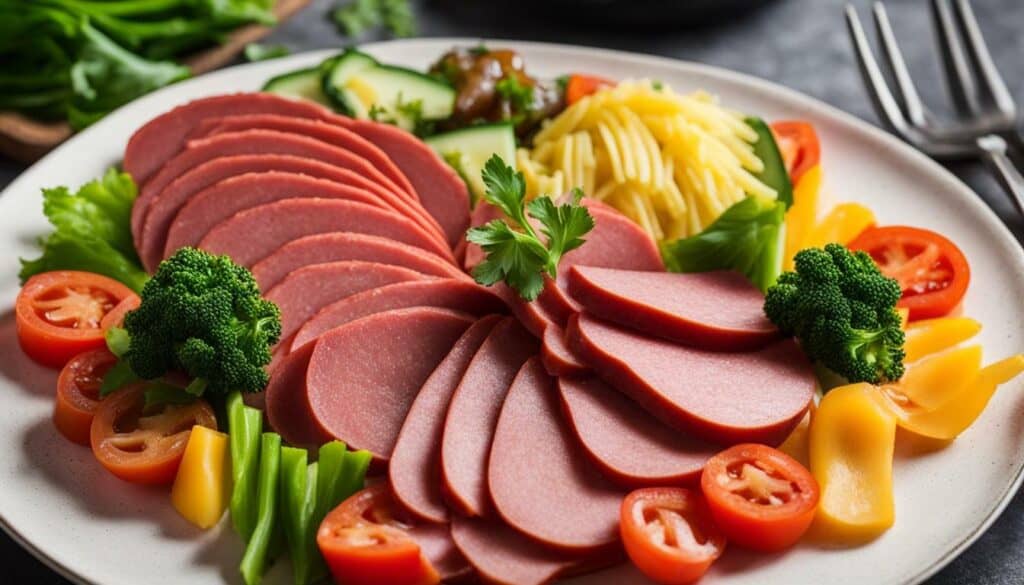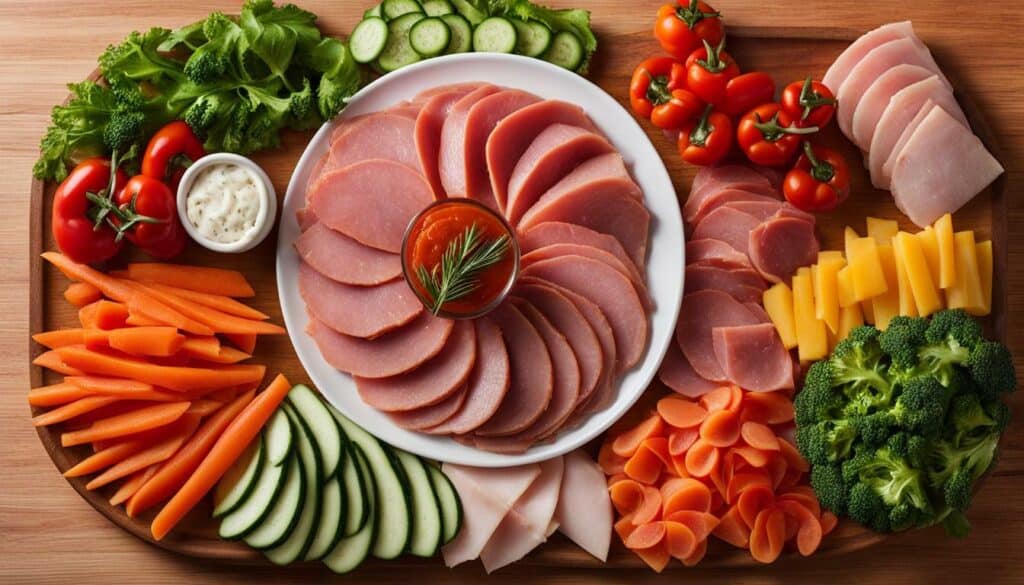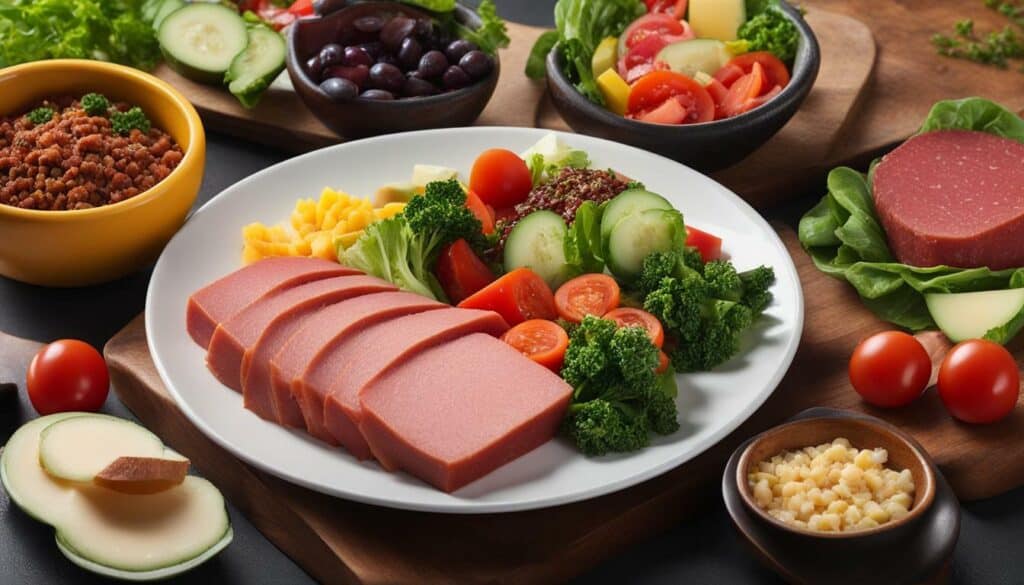Luncheon meat, a popular American staple, is often misunderstood when it comes to its caloric value and nutritional composition. Many people enjoy deli meats in sandwiches, salads, and other dishes without fully understanding the impact these foods can have on their health. In this comprehensive guide, I will shed light on the truth about luncheon meat calories, nutrition, and ingredients.
- Luncheon meat is often high in sodium, saturated fat, and preservatives.
- Regular consumption of deli meats has been linked to an increased risk of cancer, heart disease, digestive health issues, and weight gain.
- Pregnant women should avoid luncheon meat due to the risk of Listeria contamination.
- It is important to consume luncheon meat in moderation and choose leaner options.
- Combining luncheon meat with nutrient-dense foods can help create balanced meals.
Understanding Luncheon Meat Calories
Luncheon meat can vary in caloric content depending on the type and brand, with some variants offering low calorie options for health-conscious individuals. If you’re watching your caloric intake, it’s important to understand the caloric content of different luncheon meats to make informed choices about what you consume. Some luncheon meats are higher in calories, while others are lower, so it’s crucial to read labels and compare nutrition facts.
When it comes to caloric content, luncheon meats can range from around 70 to 120 calories per serving. However, keep in mind that serving sizes can vary as well, so it’s essential to pay attention to the recommended serving size on the packaging. Additionally, some brands offer low-calorie or reduced-fat options, which can be a better choice for those looking to limit their caloric intake.
Here is a table summarizing the caloric content of common luncheon meats per 2-ounce serving:
| Luncheon Meat | Calories per serving |
|---|---|
| Ham | 70-80 |
| Turkey | 80-90 |
| Chicken | 90-100 |
| Salami | 100-120 |
Remember, while some luncheon meats may be lower in calories, it’s also crucial to consider other factors like sodium and fat content. Opting for leaner cuts of luncheon meat and pairing it with nutrient-dense foods can help you create a balanced meal.
Exploring Luncheon Meat Nutrition
Luncheon meat not only provides calories but also contains essential nutrients that contribute to our overall dietary intake. Understanding the nutritional value of luncheon meat can help us make informed choices about its consumption. Let’s take a closer look at the macronutrient profile and important dietary information of luncheon meat.
When it comes to macronutrients, luncheon meat is a good source of protein. Protein is essential for muscle building, repair, and overall growth. The fat content in luncheon meat varies depending on the type and brand, so it’s important to choose leaner options that are lower in saturated fat. Additionally, luncheon meat contains carbohydrates, which provide energy for our daily activities.
Aside from macronutrients, luncheon meat also contains vitamins and minerals that contribute to our overall health. It is a good source of B vitamins, which are important for energy production and the functioning of our nervous system. Luncheon meat also provides essential minerals such as iron and zinc, which are necessary for various bodily functions.
It’s important to note that while luncheon meat does offer some nutritional benefits, it should be consumed in moderation due to its potential drawbacks. The high sodium content in processed meat can contribute to high blood pressure and increase the risk of heart disease. Additionally, the presence of preservatives and additives in luncheon meat has raised concerns about their potential impact on our health.
To make healthier choices when it comes to luncheon meat, opt for leaner options that are lower in fat and sodium. Balancing the consumption of luncheon meat with a variety of nutrient-dense foods such as fruits, vegetables, and whole grains can help ensure a well-rounded and balanced diet. By being mindful of our luncheon meat intake and making informed choices, we can strike a balance between enjoying this convenience food and maintaining a healthy lifestyle.
Unveiling Luncheon Meat Ingredients
Luncheon meat is made up of various ingredients, including additives and preservatives, which play a role in its taste, texture, and shelf life. These ingredients are carefully selected and processed to ensure the quality and safety of the product.
One common additive found in luncheon meat is sodium nitrite, which is used as a preservative to prevent the growth of harmful bacteria and to maintain the meat’s color. While sodium nitrite has been approved for use in food by regulatory agencies, excessive consumption of products containing this additive has been linked to health risks.
Other common ingredients in luncheon meat include spices, flavor enhancers, and binders. Spices such as pepper, garlic, and paprika are often added to enhance the flavor profile of the meat. Flavor enhancers, such as monosodium glutamate (MSG), are used to intensify the taste. Binders, such as carrageenan or modified food starch, are added to improve the texture and moisture retention of the meat.
It is important to note that not all luncheon meats are created equal. Some products may contain a higher amount of additives and preservatives compared to others. Reading the ingredient label and choosing products with simpler, more natural ingredient lists can help minimize exposure to potentially harmful additives.
Ultimately, understanding the ingredients in luncheon meat can help consumers make informed choices about their dietary preferences. By considering the nutritional content, caloric value, and ingredient list, individuals can enjoy luncheon meat in moderation as part of a balanced diet.
The Health Benefits of Luncheon Meat
Despite its controversial reputation, luncheon meat can offer certain health benefits when consumed as part of a balanced diet. While it is true that deli meats are often associated with high sodium, saturated fat, and preservatives, there are nutritional elements that make them a viable option for some individuals.
Luncheon meat, such as turkey or chicken slices, can be a great source of protein. Protein is essential for muscle building, repair, and overall growth. In fact, a 2-ounce serving of luncheon meat can provide around 10 grams of protein, making it a convenient option for meeting your daily protein needs.
Additionally, luncheon meat can be a source of vitamins and minerals, although the specific content may vary depending on the type and brand. For example, some varieties contain vitamin B12, which is important for red blood cell production and nerve function. Other luncheon meats may provide iron, zinc, and vitamin D.
It’s worth noting that while luncheon meat can offer some health benefits, moderation and balance are key. To reap the advantages without compromising your overall health, consider pairing luncheon meat with nutrient-dense foods. Including fresh fruits, vegetables, whole grains, and lean proteins in your meals can help create a well-rounded and nutritious diet.

| Nutrient | Average Amount per 1 oz (28g) Serving |
|---|---|
| Calories | 70-120 |
| Protein | 5-7 grams |
| Total Fat | 4-8 grams |
| Saturated Fat | 1-3 grams |
| Sodium | 250-400 milligrams |
| Iron | 2-4% of the Daily Value |
| Vitamin B12 | 4-8% of the Daily Value |
Remember to check the nutritional information and ingredients of different luncheon meat products before making a purchase. Opting for leaner options, such as low-sodium or reduced-fat varieties, can help minimize the potential health risks associated with regular consumption. Always consult with your healthcare provider or a registered dietitian to determine the best dietary choices for your individual needs and goals.
The Dangers of Consuming Luncheon Meat
Recent research has raised concerns about the potential dangers of consuming luncheon meat on a regular basis. Luncheon meat, also known as deli meat or processed meat, has become a common food in many diets. However, it is important to be aware of the health risks associated with its consumption. Deli meats are often high in sodium, saturated fat, and preservatives, which can have negative effects on our health.
Regular consumption of luncheon meat has been linked to an increased risk of cancer, heart disease, digestive health issues, and weight gain. The high sodium content in luncheon meat can contribute to elevated blood pressure, which is a risk factor for heart disease. Additionally, the saturated fat found in deli meats can raise cholesterol levels, increasing the risk of cardiovascular problems. These health risks highlight the importance of consuming luncheon meat in moderation and being mindful of the overall quality of our diets.
For pregnant women, deli meats pose an additional danger. Luncheon meat is often associated with the risk of Listeria contamination. Listeria is a bacterium that can cause foodborne illness, and pregnant women are particularly susceptible to its effects. Consuming deli meats during pregnancy can increase the risk of Listeria infection, which can have severe consequences for both the mother and the unborn baby.
To mitigate the risks associated with luncheon meat consumption, it is advisable to choose leaner options and balance their intake with a variety of other nutrient-dense foods. Opting for low-sodium and low-fat luncheon meat varieties can help reduce the negative health impact. Additionally, incorporating fresh fruits, vegetables, whole grains, and lean sources of protein into our diets can provide a balance of nutrients and promote overall well-being.
Luncheon meat poses risks for pregnant women due to the potential presence of Listeria, a harmful bacteria. Listeria can cause a serious infection called listeriosis, which can lead to miscarriage, stillbirth, premature delivery, or severe illness in newborns. Pregnant women are at a higher risk of contracting listeriosis because their immune systems are suppressed during pregnancy, making it harder to fight off infections.
To minimize the risk, it is recommended that pregnant women avoid consuming luncheon meat unless it has been heated to a safe temperature. Heating luncheon meat until steaming hot can help kill any Listeria that may be present. It’s important to note that simply reheating the meat may not eliminate all bacteria, so caution should be exercised.
It’s also worth mentioning that other types of deli meats, such as hot dogs, pâté, and cold cuts, should be avoided during pregnancy for the same reason. These products are commonly associated with Listeria contamination and should be substituted with safer alternatives.
“During my pregnancy, I made sure to avoid luncheon meat and other deli meats to protect the health of my baby. It was a small sacrifice to make for the well-being of my child.”
Pregnant women should prioritize their health and take necessary precautions to protect themselves and their unborn baby. While luncheon meat can be enjoyed as part of a balanced diet when not pregnant, it’s crucial to make safer choices during this special time. Consulting with a healthcare provider for personalized advice is always recommended.
| Luncheon Meat | Safe Consumption Practices |
|---|---|
| Heating | Heat luncheon meat until steaming hot to kill potential bacteria. |
| Alternative Options | Choose safer alternatives such as cooked meats or vegetarian options. |
| Consultation | Seek guidance from a healthcare provider for personalized advice. |

Balancing Luncheon Meat in Your Diet
Enjoying luncheon meat as part of a well-balanced diet involves finding the right balance and practicing moderation. While luncheon meat can be a convenient and tasty addition to meals, it’s important to be mindful of its nutritional content and potential health risks. By following a few simple guidelines, you can continue to enjoy luncheon meat while prioritizing your health.
1. Moderation is key: It’s important to consume luncheon meat in moderation due to its high sodium and saturated fat content. These can contribute to an increased risk of heart disease and other health issues. Aim to limit your intake of luncheon meat to a few times a week and focus on incorporating other protein sources, such as lean poultry, fish, and plant-based options, into your diet.
2. Choose leaner options: When selecting luncheon meat, opt for leaner varieties whenever possible. Look for options labeled as low-fat or reduced-sodium, as they typically contain less saturated fat and sodium. Leaner cuts of luncheon meat can help reduce your overall calorie intake and support a healthier diet.
3. Balance with nutrient-dense foods: To create a well-rounded meal, pair luncheon meat with nutrient-dense foods. Incorporate plenty of fruits, vegetables, whole grains, and legumes into your meals to increase the overall nutritional value. This ensures that you’re getting a wide range of vitamins, minerals, and fiber, which are essential for optimal health.
| Type of Luncheon Meat | Calories per Serving | Sodium per Serving | Saturated Fat per Serving |
|---|---|---|---|
| Ham | 60 | 400mg | 1g |
| Turkey | 50 | 350mg | 0.5g |
| Chicken | 45 | 300mg | 0.5g |
| Salami | 90 | 550mg | 3.5g |
Remember, while luncheon meat can be enjoyed as part of a balanced diet, it’s essential to pay attention to portion sizes and the overall quality of your meals. By making informed choices and creating well-rounded meals, you can continue to savor the flavors of luncheon meat while prioritizing your health and well-being.

Choosing Leaner Luncheon Meat Options
If you’re looking to reduce your caloric intake, there are leaner luncheon meat options available that can still satisfy your cravings. Opting for low-fat luncheon meat varieties can help you enjoy the taste and convenience of deli meats while making healthier choices for your overall diet.
When selecting leaner luncheon meats, pay attention to the fat content listed on the packaging. Look for options that are labeled “low-fat” or “lean,” as these will typically have reduced fat compared to regular luncheon meats. These leaner options are often made from lean cuts of meat and may have less added sodium and preservatives as well.
Another way to choose healthier luncheon meats is to opt for turkey or chicken instead of processed meats like ham or salami. Turkey and chicken luncheon meats are generally lower in fat and calories. They can still provide the satisfying flavor and texture you crave, but with fewer health risks associated with high sodium and saturated fat content.
| Luncheon Meat | Calories per Serving | Fat per Serving |
|---|---|---|
| Turkey Breast | 60 | 1g |
| Ham | 90 | 4g |
| Salami | 120 | 10g |
| Chicken Breast | 70 | 2g |
Remember to always read the labels and choose luncheon meats without added sugars or artificial ingredients. These can further contribute to unnecessary calories and may have negative effects on your health. By making smart choices and opting for leaner luncheon meat options, you can enjoy the convenience and flavor of deli meats while prioritizing your well-being.

It’s important to note that while choosing leaner luncheon meat options can help reduce the calories and fat in your diet, moderation is key. Aim to balance your luncheon meat consumption with a variety of other nutrient-dense foods, such as fresh vegetables, whole grains, and lean proteins. This will ensure you’re getting a well-rounded meal that supports your overall health and wellness.
Combining Luncheon Meat with Nutrient-Dense Foods
Enhance the nutritional value of your luncheon meat meals by combining them with nutrient-dense foods for a well-rounded plate. By incorporating a variety of fruits, vegetables, whole grains, and other healthy ingredients, you can create balanced dishes that not only taste delicious but also provide essential nutrients to support your overall health.
One great way to amp up the nutrient content of your luncheon meat meals is to add a colorful assortment of vegetables. Whether it’s sliced tomatoes, leafy greens, or crispy bell peppers, vegetables provide essential vitamins, minerals, and fiber that can help support digestion and promote optimal health. Consider building a refreshing salad using a variety of vegetables and topping it off with slices of your favorite luncheon meat for added protein and flavor.
Whole grains are another excellent addition to complement your luncheon meat. Opt for whole grain breads, wraps, or even quinoa or brown rice, which can serve as a nutritious base for your luncheon meat sandwiches or bowls. These high-fiber options provide sustained energy and contribute to a feeling of fullness, making your meal more satisfying.
| Benefits of Combining Luncheon Meat with Nutrient-Dense Foods |
|---|
| Increased Nutrient Intake: Adding nutrient-dense foods to your luncheon meat meals ensures that you’re getting a wide range of vitamins, minerals, and antioxidants necessary for optimal health. |
| Fiber-Rich Foods: Incorporating vegetables and whole grains into your luncheon meat meals boosts your fiber intake, promoting healthy digestion and helping you feel fuller for longer. |
| Balanced Macronutrients: Combining luncheon meat with nutrient-dense foods ensures a well-rounded meal that provides a balance of protein, carbohydrates, and healthy fats. |
Remember to keep portion sizes in mind. While luncheon meat can be a tasty and convenient addition to your meals, it’s important to consume it in moderation due to its higher sodium and saturated fat content. Pairing it with nutrient-dense foods allows you to enjoy the flavors while minimizing the potential negative effects.
So, the next time you reach for that pack of luncheon meat, be sure to combine it with colorful fruits, vegetables, and whole grains. Create a well-rounded plate that not only satisfies your taste buds but also supports your overall health.

Luncheon meat can be enjoyed as part of a healthy diet when consumed in moderation and combined with a range of nutrient-dense foods. As we’ve explored in this guide, deli meats such as luncheon meat can be a convenient and tasty option for meals. However, it is essential to be aware of their nutritional content and potential health risks.
When it comes to luncheon meat, it’s important to choose leaner options and be mindful of portion sizes. Opting for low-fat varieties and exploring alternatives can help reduce the intake of sodium, saturated fat, and preservatives. Balancing the consumption of luncheon meat with plenty of fruits, vegetables, whole grains, and other nutrient-dense foods can provide a more well-rounded and healthier meal.
It is worth noting that regular consumption of deli meats has been associated with an increased risk of cancer, heart disease, digestive health issues, and weight gain. Pregnant women should also exercise caution due to the potential risk of Listeria contamination. As with any food, moderation is key. Enjoying luncheon meat as an occasional treat rather than a daily staple can help mitigate these risks and contribute to a balanced diet.
In conclusion, while luncheon meat can be a convenient and tasty addition to meals, it is essential to make informed choices and prioritize overall dietary balance and nutrition. By selecting leaner options, practicing moderation, and combining luncheon meat with a variety of nutrient-dense foods, you can still enjoy this deli meat while taking care of your health.
FAQ
Q: Is deli meat high in sodium?
A: Yes, deli meats are often high in sodium due to the preservatives used in their production.
Q: Can deli meat contribute to weight gain?
A: Regular consumption of deli meats, which are high in saturated fat, can contribute to weight gain if consumed in excessive amounts.
Q: Are there health risks associated with deli meat?
A: Yes, regular consumption of deli meats has been linked to an increased risk of cancer, heart disease, and digestive health issues.
Q: Can pregnant women consume deli meat?
A: It is not recommended for pregnant women to consume deli meat due to the risk of Listeria contamination, which can harm the fetus.
Q: How should deli meat be consumed?
A: Deli meat should be consumed in moderation, opting for leaner options and balancing it with a variety of other nutrient-dense foods.
Q: Are there healthier alternatives to deli meat?
A: Yes, there are leaner options and alternatives to deli meat available, such as low-fat varieties or plant-based alternatives.
Are Double Stack Calories Similar to Luncheon Meat Calories?
Are Double Stack calories similar to luncheon meat calories? Many people wonder about the truth about double stack calories and how they compare to the calories in luncheon meat. It’s important to note that the calorie content can vary depending on the specific brand and serving size. It is recommended to check the nutrition labels to understand the calorie differences between these two food items.





Leave a Reply